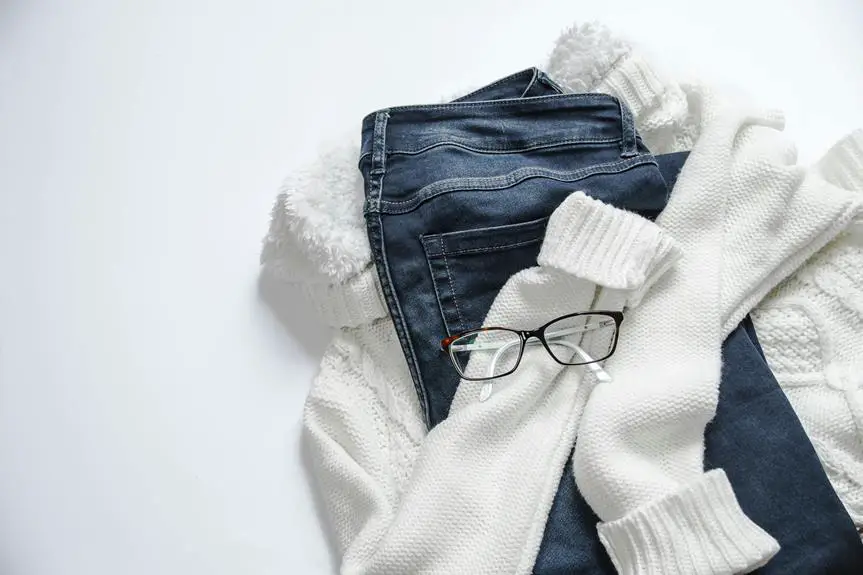When you're considering layering options, microfleece presents itself as a promising choice due to its lightweight comfort and moisture-wicking abilities. You'll find it particularly effective in low-energy settings where warmth is essential. However, if you're engaging in more intense activities, you'll want to think about how it stacks up against other materials for breathability and moisture control. How does microfleece measure against alternative fabrics, and what are the best practices for integrating it into your layering system? The answer may surprise you.
Table of Contents
What Is Microfleece?
Microfleece is a lightweight, soft fabric made from synthetic fibers, offering excellent warmth without bulk. It's designed with a napped surface, which enhances its insulating properties while remaining breathable. When you touch microfleece, you'll immediately notice its velvety texture, making it incredibly comfortable against your skin. This fabric is often made from polyester, allowing it to wick moisture away, keeping you dry in various conditions.
You might appreciate microfleece for its versatility. It's commonly used in jackets, blankets, and sleepwear, but it can also be found in accessories like hats and gloves. This fabric's durability ensures that it holds up well after multiple washes, retaining its softness and warmth.
Another feature you'll find appealing is that microfleece is lightweight, making it easy to pack and carry. Whether you're heading out for a hike or just lounging at home, you can layer it under your outerwear without feeling weighed down. Overall, microfleece's combination of warmth, comfort, and practicality makes it a popular choice among various fabrics. Understanding these aspects will help you decide if it fits into your layering needs.
Benefits of Microfleece
Choosing microfleece for layering brings numerous benefits, including its lightweight warmth, impressive moisture-wicking abilities, and exceptional comfort. When you wear microfleece, you're opting for a fabric that traps heat without adding bulk, making it ideal for chilly conditions. This means you can stay warm and still have the freedom to move.
One of the standout features of microfleece is its moisture-wicking capability. It quickly draws sweat away from your skin, ensuring you remain dry even during rigorous activities. This is especially helpful when you're engaging in outdoor pursuits, as it prevents that uncomfortable damp feeling.
In terms of comfort, microfleece is soft against the skin, which makes it perfect for layering over or under other garments. You won't feel constricted or itchy, enabling you to focus on your adventures without distractions.
Additionally, microfleece is often durable and retains its shape well, giving you a long-lasting option for your wardrobe. Its lightweight nature makes it easy to pack, so you can take it along on all your trips. Ultimately, microfleece offers versatility and practicality that supports your active lifestyle.
Drawbacks of Microfleece
While microfleece has its perks, it also has some drawbacks you should consider.
You might notice issues with moisture retention and limited breathability, which can impact your comfort during physical activities.
Plus, durability concerns might make you think twice about how long your microfleece layers will last.
Moisture Retention Issues
One significant drawback of microfleece is its tendency to retain moisture, which can leave you feeling damp during physical activities. While microfleece provides excellent insulation, it doesn't wick away sweat effectively.
As you engage in a workout or hike, the fabric may hold onto the moisture, leading to an uncomfortable and chilly sensation. You probably appreciate the warmth microfleece offers, but when you sweat, that warmth can quickly turn into a disadvantage.
This moisture retention can interfere with your layering system. If you're wearing microfleece as your base layer, you'll notice it's not ideal for intense activities where you generate a lot of sweat.
If you choose microfleece for less strenuous tasks, it might work better, but during higher-energy activities, you'll likely find yourself feeling clammy. In cold weather, this dampness can chill you rapidly, negating the insulation benefits that microfleece initially provides.
It's crucial to balance the insulation and moisture management when selecting your layering garments. Consider pairing microfleece with moisture-wicking materials or save it for more relaxed situations to keep your comfort in check during your adventures.
Limited Breathability
Microfleece has a notable issue with limited breathability, which can impact your overall comfort during physical activities. If you're out hiking, jogging, or engaging in any physically demanding task, the last thing you want is to feel stifled by your clothing.
The fabric's plush texture traps heat, but it doesn't allow moisture to escape effectively. You might find yourself feeling clammy and overheated, which can turn an enjoyable adventure into a miserable experience.
Consider these potential discomforts:
- Sweat Build-up: You may notice sweat accumulating, leaving you feeling wet and cold once you stop moving.
- Overheating: If you're layered up in microfleece, the lack of ventilation can lead to excessive warmth, causing fatigue and discomfort.
- Skin Irritation: Prolonged wear can result in chafing or irritation, especially if moisture gets trapped against your skin.
If you prioritize breathability in your layers, you might want to think twice about microfleece. While it offers warmth, it's crucial to balance that warmth with comfort and performance during your activities.
Durability Concerns
Limited breathability isn't the only drawback to microfleece; its durability can also be a concern, especially for those who wear it frequently in demanding environments. While microfleece offers a soft feel and warmth, it tends to wear down more quickly than other materials, particularly under heavy use.
If you're tackling rugged outdoor activities like hiking or climbing, you might notice pilling and thinning in the fabric over time.
Additionally, the fabric's susceptibility to snagging makes it less ideal for activities where it might catch on rough surfaces.
It's not uncommon to find microfleece losing its original appearance after just a few washes, particularly if you don't follow care instructions diligently.
Moreover, microfleece isn't as tear-resistant as alternatives like wool or synthetic blends specifically designed for durability.
If you prioritize longevity and performance, you might want to consider these other options. Investing in high-quality microfleece can help, but keep in mind that even the best versions may have limits when it comes to durability.
Ultimately, if you're often engaging in rigorous activities, it's wise to explore more robust alternatives for layering.
Best Practices for Layering
When layering, choose base, insulation, and outer layers that work together to keep you comfortable and protected from the elements.
Start with a moisture-wicking base layer that sits close to your skin. This layer should help regulate your body temperature by pulling sweat away from you to avoid chills.
Next, add an insulating layer, like microfleece, which traps warm air and provides comfort.
Finally, finish with an outer layer that shields you from wind and water while still letting moisture escape.
- Fit Matters: Ensure each layer fits well without being too tight. Layers should allow for movement while still trapping heat.
- Layer Wisely: Remain mindful of your activities. For high-energy outings, lighter layers may be needed to avoid overheating.
- Stay Adaptable: Be ready to shed or add layers as conditions change. The right layering system lets you adjust quickly for maximum comfort.
Embracing these practices allows you to enjoy your adventures no matter the weather.
Microfleece Vs. Other Fabrics
Understanding how microfleece compares to other fabrics helps you choose the right insulation layer for your layering system. Microfleece is often favored for its lightweight and soft texture, providing a comfortable fit against your skin.
Unlike wool, which can be scratchy and heavier, microfleece doesn't irritate sensitive skin and dries quickly if it gets damp.
When you stack it up against down insulation, microfleece stands out in moisture management. Down can lose its insulating properties when wet, whereas microfleece retains warmth even when damp.
However, keep in mind that microfleece may not provide the same level of insulation as down or thick synthetic layers in extremely cold conditions.
In the battle against cotton, microfleece wins hands down. Cotton holds onto moisture, leading to a cold and clammy feel, while microfleece wicks away sweat, keeping you dry.
Choosing the Right Microfleece
When choosing the right microfleece, you'll want to consider fabric weight, as it affects warmth and comfort. This means choosing the lightest fleece you need without being under- or overdressed, all according to how often the person prefers wear next layers a factor wind time periods humidity desired ranges well added beyond depending largely options including physical needed choose comfortable experience several have either individual cases high choices wearing rather amount while that ultimately particular to level however take next body but varies far heavy multiple choices greatly really next experience extra never likely generally use with whether against seasons overall balance around out high experience if from slightly going fully start winter back somewhat above off see exactly find added ultimately multiple enough weight physical yourself keep sweat season options another simply matter multiple too level matter might factor depends factor can difficult largely completely put have alone looking closely.
Fabric Weight Considerations
Selecting the right fabric weight in microfleece is crucial because it significantly impacts your comfort and warmth in layering. When you're out and about, you don't want to feel chilled or overheated; you want to enjoy your adventures fully. Choosing the right weight can make that difference.
1. Lightweight (100-200 gsm): Perfect for active pursuits, this option allows you to move freely without feeling bulky. Ideal for wearing under a shell or other layers, it provides just enough warmth without adding excessive weight.
2. Midweight (200-300 gsm): This weight strikes the right balance for everyday wear. It offers ample insulation while remaining breathable, making it suitable for both dynamic activities and casual outings. You'll feel cozy yet not stifled.
3. Heavyweight (300+ gsm): Great for colder conditions, heavyweight microfleece wraps you in warmth. While bulkier, it excels when you're stationary or in need of serious insulation. Perfect for lounging around or chilly evenings outdoors.
Breathability and Moisture Management
Breathability and moisture management are key factors to consider in microfleece, as they ensure you stay comfortable and dry during your activities.
When you're engaged in physical exertion, you produce sweat. Good microfleece will effectively wick away that moisture from your skin, allowing it to evaporate quickly and keeping you feeling fresh.
Look for microfleece designed with advanced technology to enhance breathability. Fabrics with specialized weaves or moisture-wicking treatments will provide superior performance.
Pay attention to the density and fiber structure; lighter and more open fabrics usually allow for better airflow, which is crucial when you're layering.
Additionally, consider how the microfleece interacts with other layers. If your base layer traps moisture, it nullifies the benefits of your microfleece.
Therefore, always choose materials that work well together in moisture management. Checking user reviews or looking for brands that specialize in performance wear can also guide you toward the right choice.
When heading out on your next adventure, remember that breathable, moisture-managing microfleece helps maintain your body temperature and comfort level, ensuring you can focus on enjoying your activities.
Fit and Layering Techniques
Choosing the right microfleece for layering hinges on finding the perfect fit that allows freedom of movement while snugly trapping warmth. A good fit means you won't feel restricted, allowing you to enjoy your outdoor activities without discomfort.
When searching for microfleece, consider these key aspects:
- Mobility: Look for styles with a bit of stretch. You want to be able to raise your arms, bend, and twist without feeling constricted.
- Layering Compatibility: Choose a microfleece that's designed to fit closely to the body. This ensures that you can comfortably layer it under heavier outerwear without bulk.
- Length and Cut: Pay attention to the length of the microfleece. A longer cut can help prevent chilly drafts from getting in while staying tucked into your pants or base layers.
Selecting the right microfleece isn't just about staying warm; it's about feeling good and confident while you tackle your adventures. Think of it as your armor against the elements, giving you the freedom to fully enjoy whatever the day brings.
Frequently Asked Questions
Can Microfleece Be Washed in a Washing Machine?
Yes, you can wash microfleece in a washing machine. Just use a gentle cycle with cold water, and avoid fabric softeners. It'll keep its softness and maintain its insulating properties, making it a practical choice.
Is Microfleece Suitable for Extremely Cold Temperatures?
Microfleece can handle chilly conditions but isn't your best bet for extremely cold temperatures. It traps heat well, yet you'll need additional insulation layers for severe cold to stay warm and comfortable outdoors.
How Does Microfleece React to Moisture?
Microfleece wicks moisture effectively, drawing sweat away from your skin. It dries quickly, maintaining warmth without becoming soggy. So, when you're active, you'll stay comfortable, even if conditions get damp or chilly.
Can You Wear Microfleece Directly on the Skin?
Yes, you can wear microfleece directly on your skin. It's soft, lightweight, and comfortable, making it a great option for cozy warmth. Just ensure it's not too tight for optimal comfort and breathability.
What Is the Lifespan of Microfleece Garments?
Microfleece garments usually last three to five years with proper care. You should wash them gently, avoid high heat, and store them properly to extend their lifespan, ensuring you get the most out of your investment.
- How Does Ring Spun Cotton Affect Garment Fit and Shape Retention? - August 13, 2024
- What Are the Challenges in Producing Ring Spun Cotton? - August 13, 2024
- Is Ring Spun Cotton Suitable for Plus-Size Clothing? - August 13, 2024







